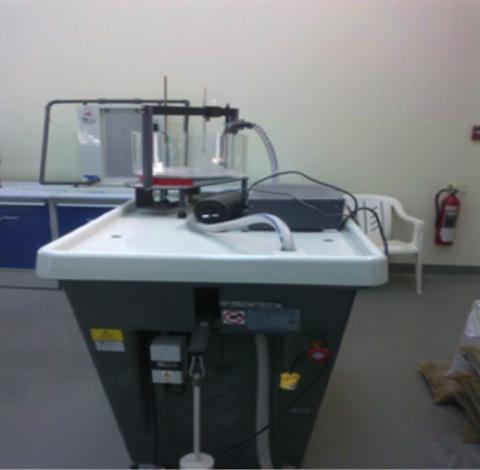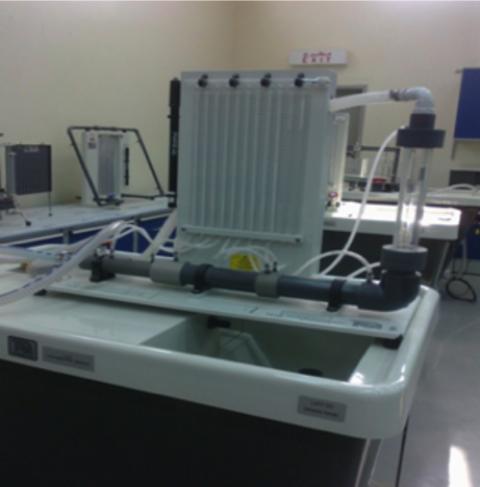The Fluid Mechanics Laboratory offers experimental and research facilities that include a wide range of specialities:
- Hydraulic test benches for measuring flow and pressure
- Equipment ot measure pipe friction and energy loss
- Laminar and turbulent flows
- Apparatuses such as: nozzles, jets, vortices and cavitation
- Flow visualization
- Pipe surge and water hammer system
- Open channel flow
- Hydrostatics and properties of fluids
- Hydrology
Applications in Other Fields:
- Oceanography
- Meteorology
- Aeronautics
- Biomedical fluid mechanics
- Convective heat transfer
- Turbulence
- Acoustics
Gravimetric Hydraulic Bench
Introduction

- The Gravimetric Hydraulic Bench provides a controlled recirculating water supply and accurate gravimetric measuring system for hydraulic and fluid mechanics experiments.
Application
The Gravimetric Hydraulic Bench is used for a wide variety of hydraulic experiments and student projects.
Volumetric Hydraulic Bench
Introduction

- Provides a controlled recirculating water supply and accurate volumetric measuring system for hydraulic and fluid mechanics experiments.
Application
The Volumetric Hydraulic Bench is used in a wide variety of hydraulic experiments and student projects that include such topics as:
- Jet trajectory and orifice flow
- Pipework energy losses
- Flow meter calibration
- Pipe surge and water hammer
- Set of weirs
- Fluid friction apparatus
- Advanced set of weirs
- Flow rate through an Orifice
- Venturi meter
- Friction loss In a pipe
- Impact of a jet apparatus
- Flow measurement
- Vortex apparatus
- Losses in piping systems
- 5 Meter flow channel
Stability of Floating Body Apparatus
Introduction

- The Stability of Floating Body Apparatus measures the metacentric height of a floating body and this piece of equipment assists in with theoretical predictions involving floating bodies.
Application
The Stability of Floating Body Apparatus determines the metacentric height and thus the metacenter of a floating pontoon. This is done by graphic analysis of the angles of tilt of the pontoon with various centers of gravity.
Orifice Apparatus
Introduction

- This instrument demonstrates flow through different orifices for different flow rates and allows for direct measurement of total head, head loss and diameter of jet.
Applications
This equpipment can help in testing the flow through a small orifice that discharges into the atmosphere and is pivotal in calculating the coefficient of discharge (Cd), coefficient of velocity (Cv) and coefficient of contraction (Cc).
Venturi meter Instrument
Introduction

- The Venturi meter Instrument directly measures static heads and enables the student to observe the pressure distribution.
Applications
Comprehensive studies of a Venturi meter and Bernoulli’s theorem can be conducted using this instrument, including:
- Direct measurement of the static head distribution along a Venturi tube.
- Comparison of experimental results with theoretical predictions.
- Measurement of the hey meter coefficient of discharge at various flow rates.
Instrument to Measure Friction Losses in Pipes
Introduction

-
- This instrument is used for direct measurements of friction loss in a small-bore horizontal pipe during both laminar and turbulent flow and directly measures friction loss in a small bore test pipe.
Applications
This instrument is crucial for the study of friction loss in a pipe, including:
- Investigations of laminar and turbulent flows.
- Demonstration and measurement in the change of the laws of resistance from laminar to turbulent flow.
- Finding the critical Reynolds number.
Impact of Jet Instrument
Introduction

- This apparatus is used to Investigates the force generated by a jet striking plates that represent turbine vanes.
- Applications
- Measuring the impact on a flat plate and comparison with momentum change.
- Measuring the impact force on a hemispherical plate and comparison with momentum change.
- Measuring the impact force on an inclined flat plate and comparison with momentum change.
- Measuring the impact force on a conical plate and comparison with momentum change.
Hele-Shaw Apparatus
Introduction

- The Hele-Shaw Apparatus is a powerful tool for demonstrating potential flow in fluid dynamics.
Application
Various flow visualization experiments are possible in two dimensions, including sink and source points and flow around models.
Flow Measurement Device
Introduction

- The Flow Measurement Device can be used to demonstarte typical methods of measuring the flow of an incompressible fluid as well as demonstrating applications of Bernoulli’s equation.
Applications
This device will aid in the study of Bernoulli’s equation, flow measurement and losses, as well as:
- Application of Bernoulli's equation for incompressible fluids
- Direct comparison of flow measurement using a Venturi meter, orifice plate and Rota meter.
- Comparison of pressure drops across each lowmeasurement device.
- Comparison of pressure drops across a sudden enlargement and a 90-degree elbow.
Center of Pressure Apparatus
Introduction

- The Center of Pressure Apparatus is used for finding the center of pressure of a totally or partially submerged plane surface.
Applications
- Studying the relationship between hydrostatic force and head of water for a fully and partially submerged vertical and inclined plane.
- Comparison of actual and theoretical hydrostatic force on a fully or partially submerged plane for any given head of water.
- Theoretical calculation of the position of center of pressure on a fully or partially submerged plane.
Flow through Channel (5-Meter Flow Channel)
Introduction

- The 5 meter flow through channel is used for experiments and demonstrations involving water flow, including weirs, gates and flumes.
- Applicaitons
- Provides facilities for experiments and demonstrations in water flow, including weirs, gates and flumes.
- Friction in a uniform channel flow.
- Flow under a sluice gate.
- The Venturi flume.
- Flow over a sharp-crested weir.
- The broad-crested weir.
Vortex Instrument
Introduction

- The Vortex Instrument allows for students to cleary see vortices and demonstrates vortex behavior, including both free and forced vortices.
Applications
- Determination of the surface profile of a forced vortex.
- Determination of the surface profile of a free vortex.
- Determination of the total head variation in a forced vortex.
- Comparison of results with theoretical predictions.
Losses in Piping System
Introduction

- This equipment mimics the flow and losses in different pipes, fittings and valves and utilizes common flow measurement instruments.
Applications
- Laminar, transitional and turbulent flows
- Use of the Pitot-static tube
- Flow measurement using a Venturi meter and an orifice meter
- Smooth pipes
- Artificially roughened pipe
- Straight pipe loss
- Sudden expansion and contraction
- Bends and elbows
- Valves
- In-line strainers
Permeability Tank Apparatus
Introduction

- The Permeability Tank testing system demonstrates and measures the flow through permeable media with common structures, such as dams or walls.
Applications
- Determination of seepage beneath a structure.
- Construction of flow nets and determination of coefficient of permeability.
- Flow under a sheet pile and determination of critical seepage force at which ‘piping’ occurs.
- Seepage flow under an impermeable dam.
- Flow through an earth dam with and without a toe drain.
- Drawdown in horizontal flow (simulation of groundwater flow into a river or well).
- Determination of uplift pressures on structures such as building foundations.
- General studies of seepage and drainage.
- Flow through a porous medium (Darcy’s law).
Pressure Measurement Apparatus
Introduction

- The Pressure Measurement Apparatus allows for a range of practical investigations into manometer and Bourdon gauge pressure measurement techniques.
Applications
A range of investigations into common pressure measurement techniques can be conducted with this equipment, including:
- Comparison of pressure measurement by manometer and the Bourdon gauge
- Calibration of a pressure gauge
- Determination of gauge errors as a function of true pressure
Jet Trajectory and Flow through an Orifice
Introduction

- This lab equipment demonstrates vertical flow and horizontal jet trajectory through different orifices.
Applications
- Determination of the contraction and velocity coefficients; hence the calculation of the discharge coefficient.
- Determination of the actual discharge coefficient by measurement of flow rate for comparison against calculated value.
- Determination of the above, over a range of flow rates to show the influence of Reynolds number.
- Determination of discharge characteristics (jet trajectory) for an orifice mounted in the side of a vertical tank and compared with simple theory.
Pipework Energy Losses
Introduction

This equipment shows losses in the bends and fittings of small-bore pipework,
Applications
Measures losses in:
- 90-degree meter bend
- 90-degree elbow bend
- Large radius, 90-degree bend
- Sudden expansion
- Sudden contraction
Reynolds Number and Transitional Flow
Introduction

-
- This equipment allows for a visual demonstration of laminar and turbulent flow.
Applications
- Demonstration of transition between laminar and turbulent flow.
- Determination of transition of Reynolds numbers and comparison with accepted values.
Liquid Sedimentation Apparatus
Introduction
The Liquid Sedimentation Apparatus is used to observe how particles settle in liquid.

Applications
- Determination of velocity distribution curves
- Comparison of flocculant and particle suspensions
- Comparison of settling characteristics of different sediments
Hydrology Apparatus
Introduction

- For students to study hydrology, including rainfall and movement of water over land and rivers the Hydrology Apparatus is a crucial piece of scientific testing equipment.
Applications
- Dewatering of excavation sites by use of wells
- Flow from a well in a confined aquifer
- Demonstration of watersheds for a simulated island with rainfall and well flows
- Sediment transport and meanders in simulated rivers
- Studies of scour around simulated bridge piers
- Simulation of multiple and moving storms
- Measurement of cone of depression for a single well
Fluid Friction Apparatus
Introduction

- The Fluid Friction Apparatus measures pressure losses in several small-bore pipe circuit components, typical of those found in central heating installations.
Application
The Fluid Friction Apparatus can be used in investigating losses in a variety of pipes and pipe system components, including:
- Straight pipe loss
- Sudden expansion
- Sudden contraction
- Bends with different radius
- Valves
- Elbows
Water Hammer Apparatus
Introduction

- The Water Hammer Apparatus is a compact piece of equipment that shows the water hammer effect and the propagation of shock waves at sonic velocity in water.
Applications
- Observing the Water hammer effect
- Propagation of shock waves in water
- Velocity of sound in a water filled pipe
- Transducer calibration
- Essential Ancillaries
